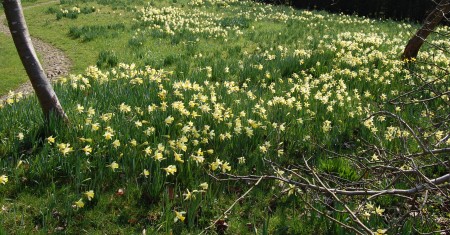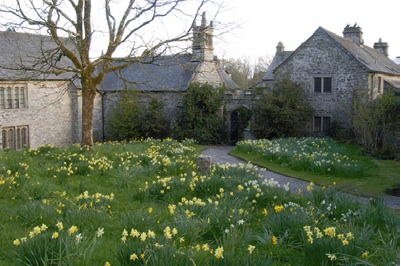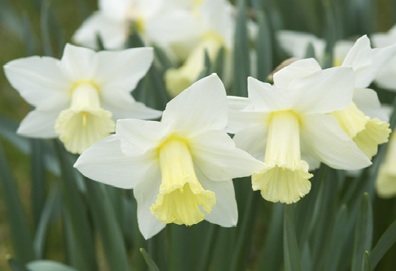Daffodils are somehow the quintessential spring flower. The appearance of their distinctive yellow flowers is a sure sign that winter has either ended or is about to soon. Unlike the tulip, which appears to be dependent on us for its continued re-emergence in the garden, daffodils re-appear faithfully every year; and not just in the garden but in places such as roadsides, churchyards and parks where they have been planted, often decades ago – in some cases over a century ago. These plants are clearly great survivors, as witnessed by the number of flowers which appear in places where they have clearly been accidentally dropped or discarded – the flowers frequently mark where someone emptied the boot of their car of garden waste into a ditch or hedge, little thinking that the event and scene of their crime would be annually and flamboyantly marked for so many years to come.

- The original seedbeds of early 20th century daffodil breeder R.O. Backhouse. This and following pictures are by Jo Whitworth.
There are around 25,000 cultivars of daffodil. Unlike other flowers: roses, tulips, orchids, whose numbers of deliberately bred varieties range across great swathes of the spectrum or show off an extravagant range of shapes, daffodils are remarkably alike. All single cultivars have the same basic shape – a trumpet (or corona) and petals (perianth); even the doubles or the strange ‘split-corona’ varieties easily betray their basic inheritance. Above all there is the colour, more or less every shade of yellow which can be imagined, but very little else: white of course, but then almost every flower has at least one white variant, some flashes of orange, but never very much, and that’s it – no-one but the breeders of so-called ‘pink’ daffodils would delude themselves that the colour is anything other than a tan-apricot. One of the fascinating things about daffodils is just how much play we can have with the same basic design and the same colour scheme; about how much breeders, the bulb trade, and us, the customers keep on coming back for more, as if we can never leave this most successful design alone, and yet at the same time not transcend it.
The daffodil as metaphor for our relationship with nature? The daffodil as cultural icon as much as the daffodil as garden plant. Daffodils appear in paintings and in poetry, as emblems of spring and of nature. This cultural status is surely a large part of their appeal; we buy them as tight buds from florists as early as we can at the end of the winter not just because they are pretty and yellow, but because Wordsworth and other poets wrote about them and they appear endlessly reproduced as a sign of spring at every level of art from the museum-hung masterpiece to the souvenir shop kitsch. The daffodil cut-flower industry is a big one, and historically it was something of a pioneer in the craft and business of how to transfer the golden promise of spring several hundred miles, from the field to the mantelpiece. The social history of this industry is a big part of the story as it has been an important driver in directing how daffodils have been bred and appreciated.
At the core of our relationship with the daffodil is how we have changed and moulded it. The key person here is the breeder. Breeders have historically been rather shy and retiring people, leaving little of historical record. Daffodil breeders have been rather the exception, in that their names tend to be better known. They are a colourful lot. Just as a taster, there is Major Ian Brodie (1868-1943), or to give him his full aristocratic title – The Brodie of Brodie (apparently everyone called him ‘The Brodie’), who between 1899 and 1942 raised hundreds of new varieties in the grounds of his Highland castle, his trial plots organised with military precision. There was P.D.Williams, brother of J.C.Williams, who revolutionised the camellia; P.D. was a noted breeder of daffodils for Cornwall’s cut flower industry. He produced several varieties which have stood the test of time, including ‘Carlton’, in 1927, which still covers many acres of the county as a cut-flower crop; however he certainly kept no records, and his reputation is that of having an intuitive, almost mystical approach to breeding.
Finally here we must mention perhaps the greatest name of all, not for his impact on what we grow in our gardens today but for his place at the heart of the development of genetic science:
William Herbert (1778-1847) was an Oxford-educated member of the gentry,a clergyman who became Dean of Manchester. Clearly one of that infamous eighteenth-century English breed, ‘the hunting parson’, he was reportedly fond of outdoor life and sport, as well as being a poet and a keen amateur naturalist. He experimented with breeding a range of flower and agricultural plants, he went on to challenge a key doctrine, that species were fixed, immutable and God-given. Most radically, he decided to make artificial crosses between daffodil species to see if it were possible that certain wild plants he had found in France were natural hybrids – and he showed that indeed they were. Shortly before his death, he published a paper on hybridization which, in many ways was very advanced for its time, suggesting on the evidence of nearly forty years of experimentation, that hybridization and species development had considerably diversified the Almighty’s original creation of the Plant Kingdom, and in doing so was a clear forerunner of Darwin’s Origin of Species.
The pictures illustrating this post were by Jo Whitworth – we’ve just got a contract together to do a book on daffodils for Timber Press, publication date not sure yet, could be 2012 or 2013.
Also, check out my own blog for news of my recent trip to the Oudolfs in Holland.




